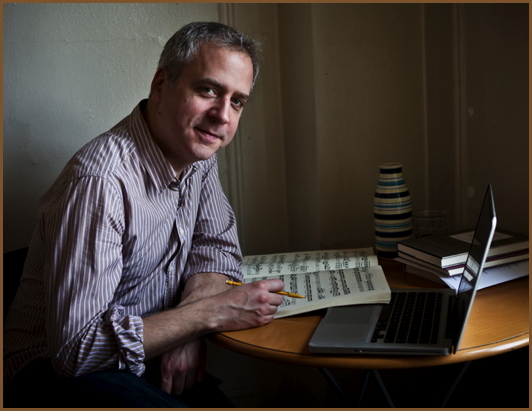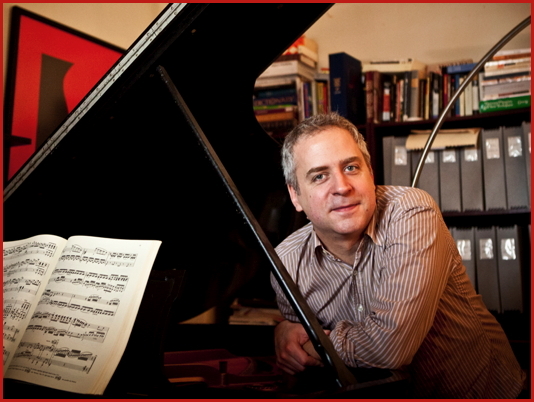Beginning this Thursday, 11/7 and through Sunday, 11/10, San Francisco Symphony (SFS) presents Mozart's Piano Concerto No. 25 in C major featuring pianist Jeremy Denk. Conducted by Music Director Michael Tilson Thomas (MTT), the program includes Beethoven's Leonore Overture No. 3; Eating Greens by Steven Mackey; and Aaron Copland's Symphonic Ode. From November 13-16 the Orchestra will be on tour, arriving at Carnegie Hall for two performances - the first, featuring the same program with Jeremy Denk, and the following evening, Mahler's Symphony No. 9. On November 15, SFS and Mr. Denk move to Champaign-Urbana, Illinois where they will appear at the Krannert Center at the University of Illinois. The tour concludes on 11/16 with Mahler's Ninth at the Hill Auditorium, University of Michigan.
For Jeremy Denk, the tour comes at a most auspicious time. Just weeks ago he was selected for the MacArthur Fellowship. The award is dubbed as a "genius grant", the recipient being nominated by others in their field. The generous stipend is extended to individuals whose work looks to be of benefit to everyone on the planet. To know the artistry of Jeremy Denk is to understand the principle of the Fellowship.
During our recent interview, Jeremy and I talked about the peculiarities of Mozart's Piano Concerto No. 25 in C Major. I mentioned the exciting parallels in Jeremy's position right now and the time in early December 1786 when Mozart debuted the concerto in Vienna. He was at a peak point in his popularity. A few weeks after that performance, the composer was in Prague presenting his just completed Symphony No. 38 in D major - known today as the "Prague" Symphony. Performances of his Le Nozze di Figaro were also underway at what is now the Estates Theatre and Mozart would conduct one of them.
Jeremy's latest CD, J.S. Bach: Goldberg Variations, released 9/30 on the Nonesuch label is currently in the top position of Billboard's Traditional Classical Albums chart. The work is the Mount Everest of piano repertoire. Jeremy is also the Music Director of the Ojai Music Festival. He has recently completed the libretto for a new opera composed by Steven Stucky and based on Charles Rosen's critical masterwork, The Classical Style. The opera will premiere at the 2014 Ojai Festival in June. Designed as an "opera buffa", the story places Mozart together with Haydn and Beethoven and surrounds them with such characters as Dominant and Tonic. I asked Jeremy if it was his suggestion to play the Piano Concerto No. 25 with San Francisco Symphony.
"It was at least partly my suggestion," he responded.
I just feel so attached to it, obviously. There are so many passages that are almost like Schubert or Mahler - this mixture of joy and sadness. Mozart is incredibly beautiful, but this piece has many shimmering passages of beauty - unearthly and uncanny. I've always had very strong feelings about this concerto. In a certain sense, it is a musician's piece. It has a lot of qualities of his other concertos, but it has others that are strange and wonderful. I've always been attracted to it. It's interesting that you're bringing up this historical parallel. It is a piece that I feel a great deal of joy playing. But the work is about this sort of mixture of the pure light of C major and the darkness of C minor. It doesn't have the same kind of singable themes that his other concertos have. It's a piece that Mozart was experimenting with - harmonic ambivalence or, put another way, bi-curious. It begins with two very clear phrases in C major. Suddenly the bottom drops out of the experience and we're in this desperately different world of C minor - and for no apparent reason. That is his first gesture of this kind of opposition of light and dark. It is an obsession within the piece - its most profound and prominent obsession. It very clearly percolates to a genial, happy rondo theme - then it's slipping on the banana peel of sadness and then recovering. It happens many times and each time it becomes this deep uncertainty.
During this 1787 whirlwind adventure in Prague, Mozart was commissioned for another opera. The end result would be Don Giovanni which premiered there in late October. How much did the surrounding atmosphere of these theatrical successes influence the construction of this piano concerto?
I think it's less conventionally theatrical than some of the other nearby concertos. It has an experimental aspect to it, testing the boundaries of what the style can bear. How obsessively can he treat this motif - the sort-of motif of Beethoven's Fifth. Like any Mozart piece, it has its theatrical flair. In a way, nothing could be more theatrical than its grand opening followed by this sudden turn to minor. The piece feels like it's something that Mozart wrote not for his own pleasure, but inspiration. What I experience is like shivers of surprise and shock. The concerto prefigures a lot of what Beethoven was going to do - expanding the realm of what a single motif can bear. It also prefigures that Schubertian instability at the heart of things. It has a sort-of insider baseball quality. Charles Rosen in The Classical Style writes that this concerto has always been seen by musicians with special affection. I have a feeling that it is a special piece for him too. There are so many transitions that are almost deliberately bizarre or awkward, that explore possibilities of how I can make this work.
Jeremy's blog, think denk is a gold mine of essays and exchanges that reveal the heart and soul of the man and his music. Like a great Shakespearean actor on tour, there is always the question of personal stamina and maintaining one's "motivation for being in the room". Given the musical complexities within the Piano Concerto No. 25 in C major, how does Jeremy keep the creative juices going during the course of a tour?
Some people describe this piece as cold. I don't know what they're listening to. For me, the middle section of the last movement has the most beautiful and heart rending passage in all of Mozart. It starts out as a kind-of A minor episode, a sad episode within the rondo - which would be normal enough, a business-as-usual for a classical rondo. Then it peters-out and launches into this F major theme. If it were only for those two minutes of the piece, it would be one of my favorite pieces in the world. It's this incredible F major theme which is everything that the piece -- up to now -- has not been. It has a flow, a fullness. At the end of that F major paragraph, the C minor comes back again in and wings through this unbelievable prolongation of the theme of joy turning into tragedy. He looks at this ambiguity for such a long time and in such an extreme way. That's a rather over-the-top way of describing it. This piece is an obsession of mine and it is an obsessive piece. I am thrilled that Michael Tilson Thomas agreed to do it and I can't wait to do it.

